Table of contents
- Test assistance systems part 2 Six models: traction control in the test
- Traction control in the event of a jump in the coefficient of friction
- Traction control in wet conditions and when cornering
- Traction control in dry conditions
- BMW S 1000 RR
- BMW R 1200 GS
- Ducati 1198 S.
- Kawasaki 1400 GTR
- MV Agusta Brutale 1090 RR
- Yamaha XTZ 1200 Super Tenere
- What does the future hold?
- The function of different systems
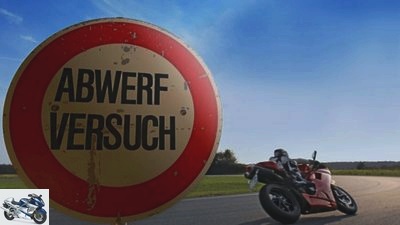
Jahn
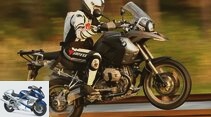
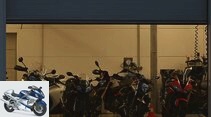
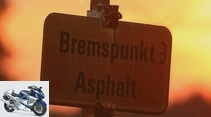
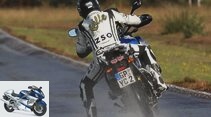
13th pictures
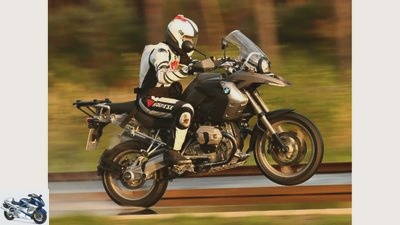
Jahn
1/13
The relations shift on the wet test track – in the truest sense of the word.
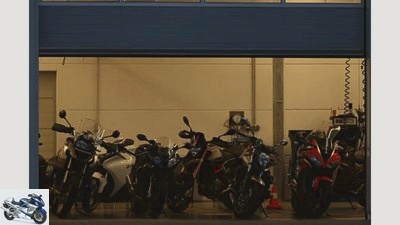
Jahn
2/13
In conclusion, it can be said that assistance systems such as ABS are now at least part of the optional basic equipment of almost all well-known manufacturers.
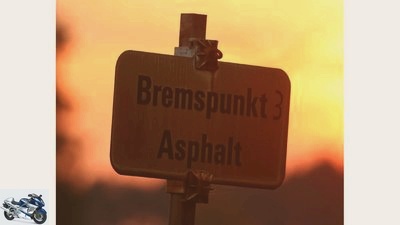
Jahn
3/13
Do you even need traction control in good road conditions??
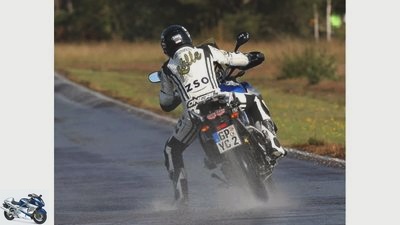
Jahn
4/13
Jump in coefficient of friction – the technical term for a suddenly changing grip on the road surface.

Jahn
5/13
The relatively simple system of the Kawasaki 1400 GTR surprises with its sensitive control behavior and cuts a good figure on the wet track.
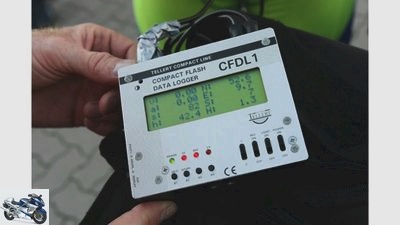
Jahn
6/13
The measured data was meticulously evaluated and compared by our team.
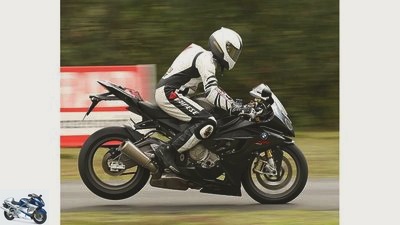
Jahn
7/13
On a dry track, the individual concepts have to prove their maximum deceleration ability.

Jahn
8/13
The sensor in the aluminum square measures the wheel speed for the slip measurement.

Jahn
9/13
Another criterion in our test was whether and how ABS works in an inclined position.
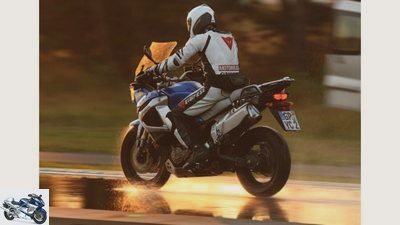
Jahn
10/13
Although the structure is relatively simple, the Yamaha Super Tenere’s solution is pleasing with sensitive intervention on wet surfaces and slippery sand fields.
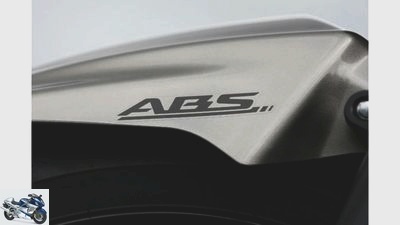
Jahn
11/13
The ten best-selling models of the past two years in Germany are now equipped with ABS.
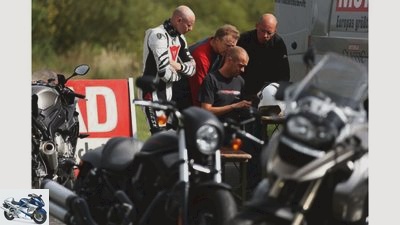
Jahn
12/13
Four different test modules, plus a demanding test set-up – this is how the individual bikes and their respective systems were tested by MOTORRAD.

Jahn
13/13
In the first traction control test of its kind, MOTORRAD scrutinized all current systems and manufacturers.
accesories
Assistance systems: traction control in the test
Test assistance systems part 2
Six models: traction control in the test
Traction controls are finding their way into series production more and more, even with tourers. In the Contidrom, MOTORRAD put all current systems to the test in the first traction control test of its kind. What works, what doesn’t?
Andreas Bildl
10/28/2010
“A start has been made.” The conclusion after testing the first standard slip control, the ASC of the BMW R 1200 GS, was not really euphoric. That was in early 2007.
BMW had taken on the honorable and ungrateful pioneering role in matters of slip control. The ASC was primarily intended to defuse everyday situations. Almost a year later, Ducati served the racetrack faction with the 1098 R with a system that was to be derived from the factory superbikes. After all, nothing works in MotoGP and the Superbike World Championship without this aid. BMW moved with the S 1000 RR to. And that Kawasaki 1400 GTR, MV Agusta Brutale and F4 as well as Yamaha XT 1200 Super Tenere have slip control, shows that the manufacturers see sense and benefit, especially in daily use, where rapidly changing surfaces, rain, sand, oil and manhole covers lurk.
Buy complete article
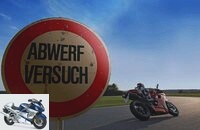
Test assistance systems part 2
Six models: traction control in the test
10 pages) as PDF
€ 2.00
Buy now
So far so good. But what exactly does such a traction control actually do, whom and when does it use it? And are falls over the rear wheel a thing of the past? Basically, traction control does nothing more than take away drive power from the rear wheel. However, it cannot influence the transverse force, which increases with the incline. Therefore, if the angle is too great and the grip is too low, falls are still possible. And while racers use traction controls to get faster, they should first and foremost ensure more safety in everyday life. And how does it all work? Now it’s getting technical – and exciting.
Click here for the assistance system test – Part 1: ABS
MV Agusta goes its own way with Brutale and F4. The relatively simple system uses a sensor at the transmission output to measure how quickly the speed is increasing on the rear wheel and compares this with stored gear-specific acceleration curves. If the rear wheel revs up too quickly, the electronics intervene in the ignition and injection, which ranges from adjusting the ignition point to reducing the injection quantity to switching off entire ignitions or injection cycles. Regardless of the inclined position. All other systems measure the speeds of the front and rear wheels. If these deviate too much from one another, the slip must be. Theoretically. But it could also be a wheelie. Or simply a lot of inclination. Because the rolling circumference of the tire decreases on the flank, i.e. with increasing lean angle more at the back than at the front. And this especially with wide sport skins.
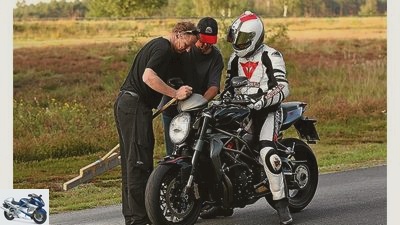
Jahn
“Ui! That was close. Is the traction control really switched on??!
While the MV driver lively wheezes because of the lack of speed adjustment of the wheels, Tenere and GS intervene in the power output with a front wheel lob. Because your Enduro tires do not show any major deviations in the contour, your traction controls remain practically silent when cornering quickly. Especially since a small deviation for inclinations is mathematically taken into account in the programmed algorithms. And what about the superbikes? Are much more sophisticated systems in use. Logical. While with naked bikes, touring bikes and enduros, the main focus is on civil use, athletes have to be protected from take-off, even with enormous lean angles and heavy demand for performance. Ducati uses a sophisticated system for its eight-stage traction control (DTC) that not only includes the wheel speed, but also the throttle position, gear, speed and engine speed. From this, the Duc uses complex calculations to generate the inclination every few milliseconds (how often, exactly, Ducati is silent) over calculated rolling circumferences. However, this is only reasonably reliable for a precisely defined tire contour. In comparison with the data from an acceleration sensor, the system can ultimately differentiate between riders and wheelies. Only the BMW system of the S 1000 RR goes one step further.
Using two gyro sensors, microelectronic components for recording angular speeds, it calculates the actual lean angle to one degree, largely regardless of the type of tire.
If the Ducati wheel sensors deliver six impulses per wheel revolution at the front and four at the rear (via brake disc floaters or screws), the BMW system receives 48 impulses per revolution via the perforated rings on the brake discs. The best prerequisites for faster detection and finer control of slip.
In contrast to the other machines, thanks to ride-by-wire, the BMW electronics first access the throttle valve at lightning speed. Which is only feasible if it is very close to the inlet valve due to the short intake path. Only when that is not enough will the ignition and injection be intervened.
But be careful: if you already see yourself painted horizontally standing black lines on your house route, be warned: These systems are no license for guaranteed consequence-free, unrestrained gasping. You can slow down or prevent riders by reducing the pulling force on the wheel. But they can neither push the boundaries of physics nor create additional grip. If the lateral force exceeds the grip conditions, the driver finds himself back on the groundwork. Stoner, Lorenzo and Co. had to find out about that too.
Traction control in the event of a jump in the coefficient of friction
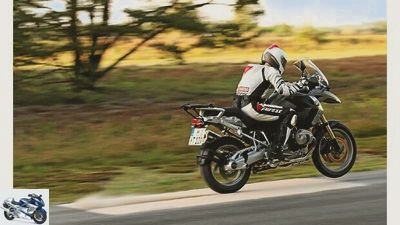
Jahn
The jump in the coefficient of friction involves two sandy areas that are supposed to make the rear tire spin properly.
Not paying attention for a moment, overlooked the greasy spot, the shovel full of sand that careless road workers had distributed or simply turned the whisk too heartily because you were just so beautiful in the river – and it happened: ground contact.
That should no longer happen with the six test persons because they recognize slip. But how good? To do this, we drove into the measuring section at 40 km / h and then accelerated fully. After ten meters there is a three meter long sand field, three meters further the next one. The Ducati begins its eight-stage DTC (Ducati Traction Control) in the eighth and therefore most sensitive stage. In first gear, the Bolognese jerks her front wheel up in the air and wheelt over the sand. Too much pressure from below. Second gear, still level eight. The Duc roars over the first sand field, the rear wheel spins briefly, and the DTC brakes it just past the sand fields 1198 stuttering. Even regulates the speed back a little. Only after the sand is a long way back does the Duc shoot away at full power. The 1198, for example, needs 3.3 seconds and 58 meters from 40 to 80 km / h across the sand fields.
Next round, now with level four. Now there is noticeably more slip on the sand. But the Ducati regulates accurately, albeit a bit roughly, and allows full power again shortly after the sand fields. 2.3 seconds and 39 meters later, 80 km / h are reached. In level one, the values drop to 1.9 seconds and 32 meters. Without any DTC, the Duc managed 1.6 seconds and 26 meters. Although these figures do not allow a comparison with the other machines, they clearly illustrate the different effects of the various DTC levels.
Automatic Stability Control (ASC) from BMW R 1200 GS has only one mode for the street – and it goes to work in a down-to-earth manner. The control processes on the sand are clearly audible and comparatively rough, as is the intervention when the front wheel is lifted off. But the GS stays clean on course.
The electronics of the are much softer Yamaha Super Tenere into the action. Both in the “cautious” Level one, as well as level two, which allows more slip, the control processes are pleasantly smooth. The influences on the chassis are minimal.
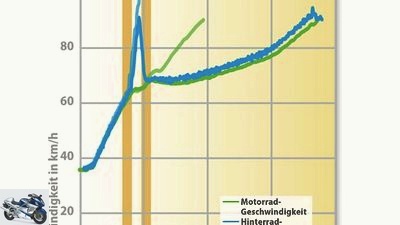
Drawing: archive
Traction control of the Kawasaki 1400 GTR: The vehemently spinning rear wheel causes the electronics to massively reduce the power. The GTR only reaches 90 km / h after 76 meters, without K-TRC after 39 meters.
And the four-cylinder? Of course, all eyes are on the BMW S 1000 RR. With a little trick and Tellert data recording, the work of your Dynamic Traction Control (DTC) is completely recorded. With interesting results (see boxes on p. 33). To warm up, top tester Karsten Schwers accelerates the BMW over the sand in sport mode. As soon as the rear wheel is on the sand, the electronics brakes the BMW gently, releases power again when the asphalt is reached and regulates the second sand field just as finely and quickly.
In the tightened slick mode, the BMW accelerates vehemently, but without breaking the rear wheel over the sand. The electronics only seem to throttle the performance slightly. What goes on behind the scenes: Please look at the diagrams on this page and be amazed.
the MV Agusta Brutale has the same eight-stage system as the Superbike F4. But regardless of whether there is no traction control, in the gentlest or sharpest setting, she always rushes over the first sand field with a scraping rear wheel, jumps onto the rear wheel as soon as the tire grips on the asphalt and dashes across the second sand field in a wheelie. Their values always fluctuate by 1.8 seconds, and so the MV reaches 80 km / h after about 29 meters. There is no real effect of the electronics. According to MV Agusta, traction control is only active from 4000 rpm. But on the one hand it was not understandable, on the other hand, such an interpretation is not very practical.
In contrast to the Kawasaki 1400 GTR. As soon as the rear wheel spins and the system recognizes that this condition extends over several meters, it regulates the power gently but drastically and only gradually releases more power. On the second sand field there is no longer any spinning of the wheel. This is reminiscent of a snail that pulls back in a flash when it comes into contact with its feeler and only slowly comes out of the house again when the danger is over. The GTR accelerates slowly, but – in contrast to the Ducati – constantly.
Traction control in wet conditions and when cornering
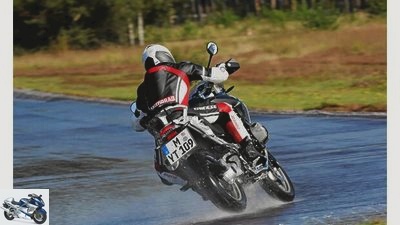
Jahn
Here the GS can venture deep into the water.
Wet leaves, rain, surprisingly greasy Dolomite asphalt. There are enough situations in which the grip on the road does not hold up, what was expected from it. What excellent crap weather. It’s been raining like buckets for hours. The fingers are more than clammy, the feeling in the hands is bad. And the tin can in front has been twitching for what feels like an eternity.
But now, after the next bend, there is room to overtake. Not much, but with a lot of gas it should be enough. Corner exit, tap open. It would be nice if the electronics now ensure that you are not overtaken by your own rear wheel when you accelerate.
But what do the systems of the six machines really do in wet conditions? A clear case for the wet handling course in the Contidrom and the irrigated acceleration section. First discipline: the sprint from zero to 100 km / h.
The traction control (TK) on all machines ensures a problem-free sprint accompanied by more or less pronounced hip wobbling. Only the MV Agusta – like on the sand fields – does not care whether its TK is at level one or eight or is completely switched off. Their values fluctuate from zero to one hundred with an audible slip and without recognizable intervention by the TC by 4.5 seconds. Differences? Nothing.
With the Ducati, the twin’s enormous torque is a tough nut to crack for the DTC. On the gentle level eight, it accelerates even better with 5.2 seconds than in the racing-like, sharp level one (5.7 seconds), which is the slowest times overall. Why? The rear wheel spins so quickly under the onslaught of torque that the DTC rigorously intervenes in the engine management and inhibits the forward thrust even more than in the early regulation level eight.
The Kawasaki flies through the water while sprinting in an unobtrusive manner. Your K-TRC keeps the load stable on course. While the BMW S 1000 RR in sport mode manages the sprint in 5.4 seconds despite the minimally profiled sport tires. The slick mode makes optimal use of the grip of the tires: a respectable 4.8 seconds, while the rear wheel, with its 200 hp, has a lot of trouble without any DTC. Result: wildly wagging 5.8 seconds.
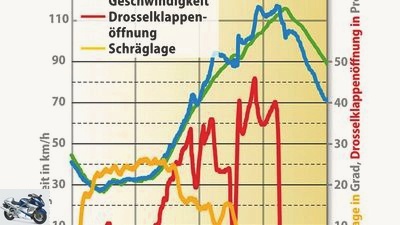
Drawing: archive
Traction control of the BMW S 1000 RR: The BMW drives through the curve at an angle of about 25 degrees. When standing up, the gas is drawn up. You can clearly see how the throttle valves are closed and immediately opened again on the first slide. The game repeats itself permanently, so the BMW driver always works his way to the limit of grip and the optimum acceleration.
But the enduros provide a real surprise. Especially the Yamaha. Thanks to the extremely grippy Metzeler Tourance EXP and sensitive control electronics, it manages the sprint in a fantastic 3.9 seconds on the second and therefore sportiest level of its traction control. Even the more powerful BMW GS, fitted with the same tires, has to fit because of the roughly regulating electronics.
The picture is similar when accelerating out of a wet curve on the handling course. At MV Agusta, colleague Schwers stopped searching for the control range after a few audible slides without noticeable intervention by the electronics.
The S 1000 RR with its sport skins allows an incline of almost 25 degrees. If the gas is drawn in too briskly, your DTC will normally intercept the following slide in good time and gently. It actually works quite well. The Ducati only intervenes in stage four after a somewhat more pronounced moment of shock and then much more coarsely. At level eight, on the other hand, the Duc regulates audibly and more than necessary. The optimal coordination should be somewhere in between. By intervening earlier and more gently, the BMW conveys the feeling of preventing floor damage in case of doubt, which guest tester and IDM supersport racer Christian Kellner also confirmed. In any case, both are effective aids in wet conditions.
The massive Kawasaki also made a good impression. Your good-natured performance provokes, unless the gas is maliciously pulled roughly, not lightning-like, but rather gently onset slides. Then the heavy stern swings out gently and is also caught again.
The Yamaha XTZ 1200 is also good-natured. As with the Alpine Masters, it is particularly convincing here in the gentler first of the two TK levels. The second intervenes almost too late. At level one, however, it offers a decent level of security.
Traction control in dry conditions

Jahn
In dry conditions, the traction controls should show whether they are profitable under good conditions.
Do you even need traction control in good road conditions? In addition to sports riders, do touring riders also benefit from it? No reasonably gifted person should come up with the idea of using traction control in a targeted manner in the wild between crash barriers, oncoming traffic and trees. Nevertheless, when turning, when it is cold or when the tires are simply still cold: There are situations where it would be good to have this helper on board. And on the racetrack it makes it easier for racing foxes to find the limit area and faster lap times anyway.
So the last act: Fire free on a dry slope, the Contidrom’s handling course. Eternally long, fast corners alternate with tight chicanes, interrupted by a hairpin. With a halfway life-affirming driving style, the systems of the Tenere and the BMW GS in particular can hardly be used. On the one hand, the possible lean angles are limited, especially with the Yamaha, which chipped its footpegs on the asphalt with spraying sparks at an early stage. On the other hand, the tires offer a lot of grip for the performance they offer. Only when it comes out of switchbacks in first gear with coarsely torn gas and the next gear is knocked hard on the limiter, the control systems come into action. With the Tenere it is softly regulated on the milder level one, with the GS later and, as before, coarser. However, these systems are not intended for this. Even the Kawasaki 1400 GTR In view of the possible lean angles, it offers so much tire contact area and grip that the traction control practically does not have to intervene.
It looks a little different with the potent four-cylinder engines. The first finding, however, is: Even the road sports tires of the three offer so much grip under optimal conditions that you have to pull the gas quite consistently to provoke slides.
Once again, the MV caused a frown, which could only be elicited from a very slight stutter when accelerating as a sign of possible regular activity at the end of a second-gear chicane at full throttle from around 8500 rpm. Even a slide at the hairpin bend over a row of metal mushrooms set into the lane seemed to capture the grip of the Dunlop Qualifier RR more than the electronics. So, also in view of the performance in wet conditions and on sand, there was a rather ambiguous impression than that of a reliably regulating system.
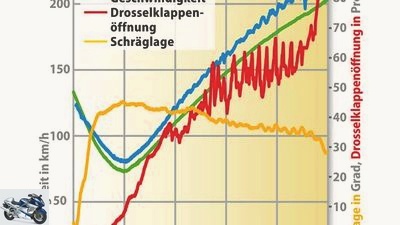
Drawing: archive
Traction control of the BMW S 1000 RR: At a lean of well over 40 degrees, the rider pulls the throttle on the S 1000 RR. As soon as slip sets in, the DTC regulates sensitively and very quickly via the throttle valve.
The electronics from BMW and Ducati come into action much more clearly. At level eight, however, you don’t need to get the Duc dry. With a large lean angle, the difference in the rolling circumference between the front and rear tires is so great that the DTC control lamps in the cockpit flicker frantically when driving quickly into chicanes. And at the exit of the bend, the rider in a hurry is slowed down much too early by the hacking electronics. To change the DTC, however, you have to stop and muddle through the operating menu. However, it is not quite as jumbled as the operation of the MV Agusta.
Level four allows much more propulsion and also more slip. The DTC regulation is decreasing, the control lamps in the cockpit flicker significantly less. Every now and then, however, there are also short and crisp slides that are just as rigorously slowed down again. A good compromise for a trip to the racetrack.
Choosing an even lower DTC level that allows even more slip only makes sense with skins that are more grippy. Anyone who wants to change the traction control setting at BMW is fine. It can be conveniently selected on the handlebars while driving at the touch of a button. Pulling the clutch within 30 seconds activates the selected level. Compared to the Ducati, the BMW regulates a little earlier and finer in sport mode. Even the race mode does not provoke any too wild slides. More than with the Ducati, you have the feeling that you are always caught again in time. Christian Kellner and Karsten Schwers are thrilled. The Ducati system is also good in the dry, but the elaborate BMW system also proves to be the better here.
BMW S 1000 RR

Jahn
BMW S 1000 RR
The Bosch system from BMW is not only the easiest to use, it is currently also the most highly developed system. It gives you a very secure feeling when you intervene.
BMW R 1200 GS
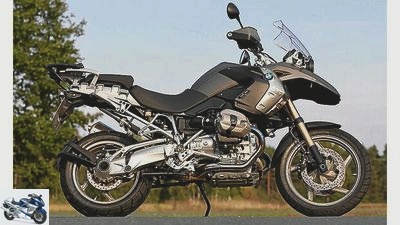
Jahn
BMW R 1200 GS
The ASC of the GS regulates only half as fast as the DTC of the S 1000 RR. The interventions in practice are correspondingly rough. An acceptable aid on loose ground and if the incline is not too great.
Ducati 1198 S.

Jahn
Ducati 1198 S.
The Ducati system does not achieve the control quality of the BMW superbike. But it offers good support for the racetrack. And in the pit lane, the cumbersome operation is not that annoying.
Kawasaki 1400 GTR
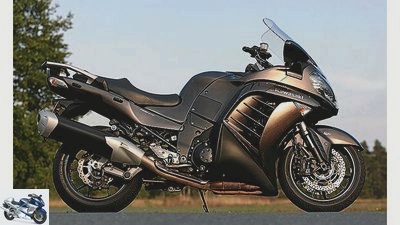
Jahn
Kawasaki 1400 GTR
The relatively simple system surprises with its sensitive control behavior and cuts a fine figure on the wet track. A thoroughly successful idea for the intended purpose.
MV Agusta Brutale 1090 RR
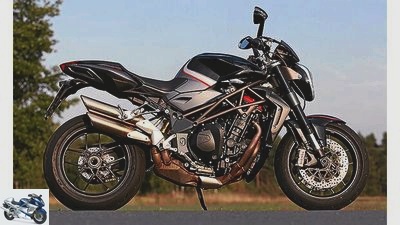
Jahn
MV Agusta Brutale 1090 RR
Rather trust the gas hand and Popometer, is the motto at the MV. The control was not convincing in the wet and with a jump in the coefficient of friction. On dry roads in everyday life, its benefits are academic.
Yamaha XTZ 1200 Super Tenere
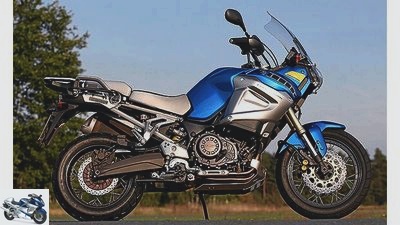
Jahn
Yamaha XTZ 1200 Super Tenere
Although the structure is also relatively simple, the Yamaha solution pleases with sensitive intervention on wet surfaces and slippery sand fields. But as with the BMW, its use on dry roads is rather limited.
What does the future hold?
Almost every manufacturer is still cooking its own soup. The systems from Ducati and above all those of the BMW S 1000 RR, which is the only one that works with two expensive gyro sensors for lean angle measurement, have proven to be the most efficient. The next generation will be smaller and have a third gyro sensor. This should also enable wheelie detection and launch control, as well as effective lift-off detection of the rear wheel in the event of ABS emergency braking.
But in addition to Ducati, Kawasaki does not rely on a system with lean angle sensors in the new ZX-10 R, but solely on acceleration sensors and complex calculation models using algorithms to determine the lean angle. It remains to be seen what will prevail or whether both systems will remain on the market equally. In any case, traction controls, ABS systems and engine management will be networked with one another in the future. In the opinion of Matthias Morbe, the chief developer responsible for lean angle sensors at Bosch, the traction controls will no longer just reduce power, but will also set specific torque specifications for the engine management system. Also to reduce the drag torque on the rear wheel. In addition to self-learning systems for different types of tires, a combination with active chassis is also conceivable. Cornering lights have already been implemented in the BMW K 1600 GT, but stability control with braking intervention in an inclined position is also conceivable, similar to the ESP in cars. An ABS with pressure supply would be required for this. But cornering ABS could also be based on refined lean angle sensors.
The function of different systems
BMW S 1000 RR:
Speed comparison of the wheels, lean angle sensors, intervention on the throttle valve and engine management.
BMW R 1200 GS:
The ASC records the front and rear wheel speed. Intervenes in ignition and injection.
Ducati 1198 S:
Acceleration sensor, wheel speed comparison, detection of gear and speed, lean angle is calculated.
MV Agusta Brutale 1090:
Measures the speed of the increase in speed on the rear wheel, intervention in ignition and injection.
Kawasaki 1400 GTR:
Comparison of wheel speeds, accesses throttle, ignition and injection.
Yamaha XTZ 1200 Super Tenere:
Wheel speed adjustment, first changes ignition, then injection, then throttle valves.
Related articles
-
Motorcycle anti-lock braking systems in a comparison test
Jahn 13th pictures Jahn 1/13 The relations shift on the wet test track – in the truest sense of the word. Jahn 2/13 In conclusion, it can be said that…
-
Electronic driver assistance systems for motorcycles
Yamaha 35 pictures www.factstudio.de 1/35 How things are going? It was a long way from the almost purely mechanical cockpit of the Yamaha SR 500 to the…
-
Cornering ABS and traction control regulate more often than expected
Photo: markus-jahn.com 6th pictures Bosch 1/6 The so-called curve ABS at a slope of 35 degrees on dry asphalt. The driver brakes in an inclined position,…
-
Test: retrofittable traction controls
fact accesories Test: retrofittable traction controls Test: retrofittable traction controls Traction controls from Bazzaz, Grip One and IRC Content of…
-
Ducati 1299 Panigale assistance systems coordinate setup
markus-jahn.com 28 pictures fact 1/28 Ducati Superbikes in a generation comparison. fact 2/28 Bite-proof and easy to dose: anchor of the 1198. ABS was…
-
Traction control Ducati 1198S, C-ABS Honda Fireblade
K 28 pictures Honda 1/28 Honda 2/28 Honda 3/28 Honda 4/28 Honda 5/28 Honda 6/28 Honda 7/28 Honda 8/28 Honda 9/28 Honda 10/28 Honda 11/28 Honda 12/28…
-
4 lean ABS systems in the endurance test
4 lean ABS systems in the endurance test Lean ABS systems put to the test 4 current curve anti-lock braking systems in comparison Full in the irons with…
-
Cornering ABS MSC from Bosch in the test
Bosch 11 pictures Bosch 1/11 The schematic diagram shows the brake lines from the modulator to the wheel brake cylinders. Bosch 2/11 “Thank you, Dr….
-
Additional safety through assistance systems
Security campaign Consideration has right of way Yixin Chen 7th pictures Yixin Chen 1/7 Bosch 2/7 Adaptive Cruise Control adapts the speed to the flow of…
-
Kawasaki with radar-based assistance systems from 2021
Motorcycle fair in Milan EICMA 2021 Presented by Kawasaki counselor technology & future Kawasaki with radar-based assistance systems from 2021 Kawasaki…